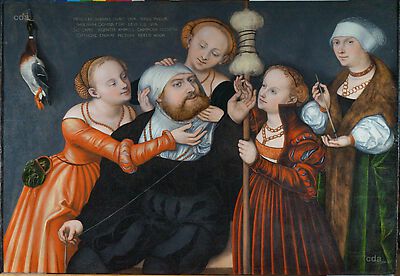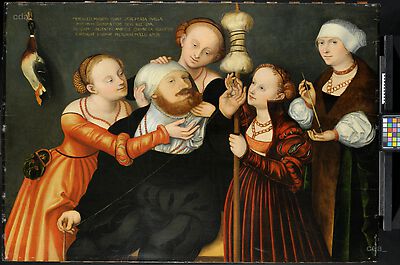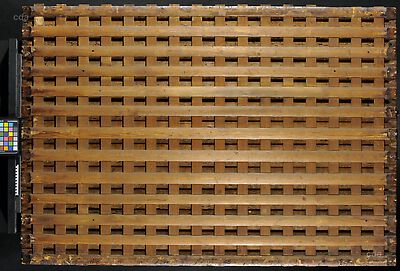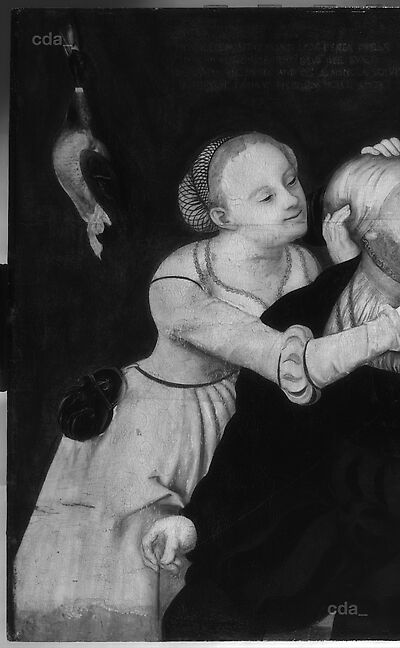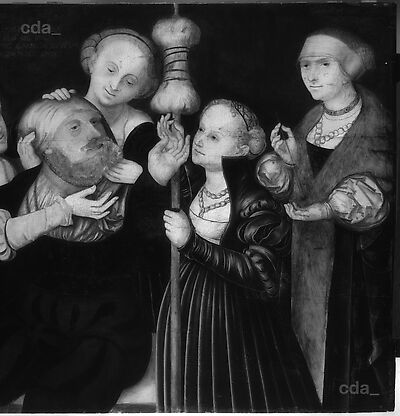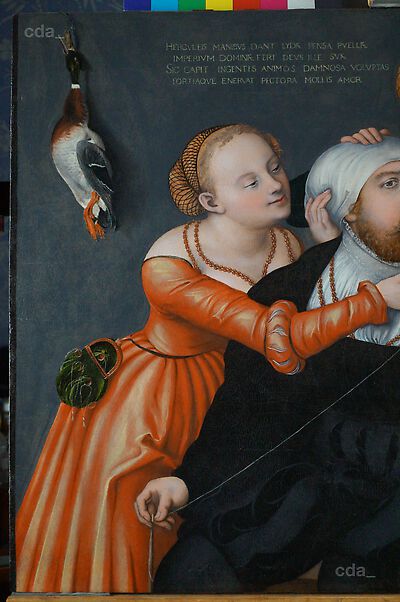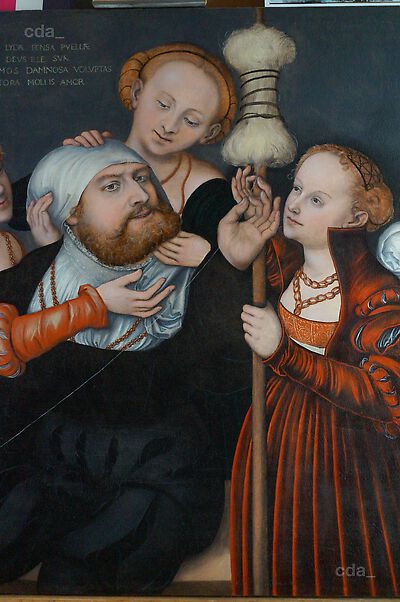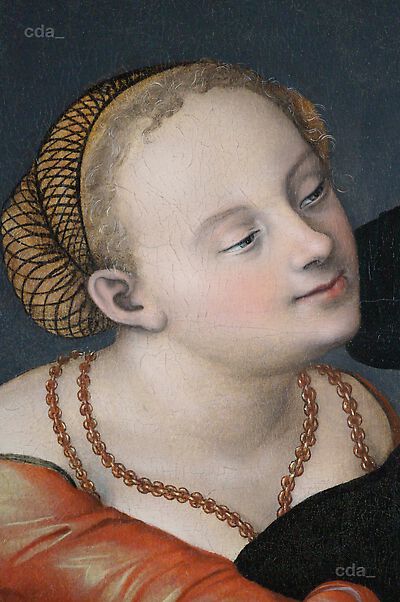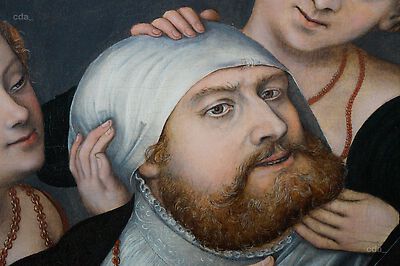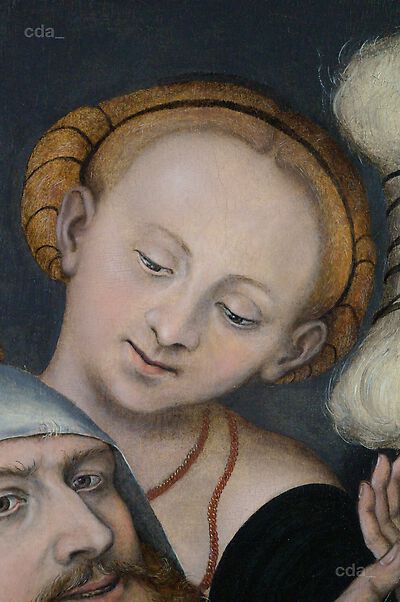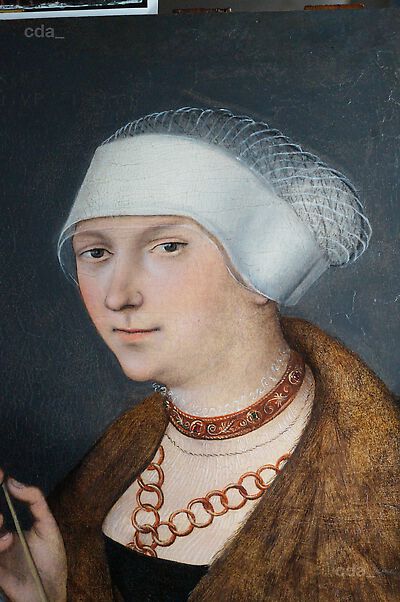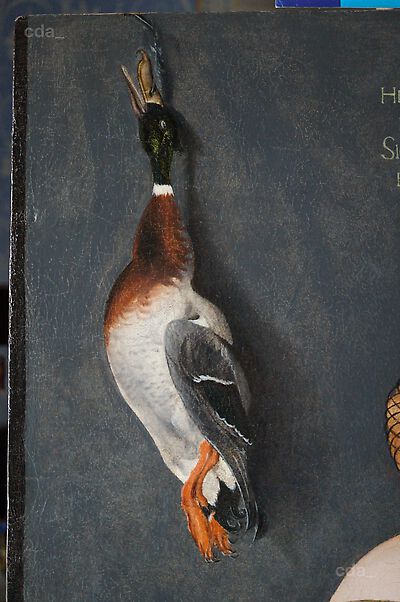The panel shows Hercules sitting on a bench spinning thread. He is surrounded by three maids who hold the thread and distaff while placing a white cloth on his head. Omphale stands in regal dress to the right of the image and looks out at the viewer. A dead drake
The panel shows Hercules sitting on a bench spinning thread. He is surrounded by three maids who hold the thread and distaff while placing a white cloth on his head. Omphale stands in regal dress to the right of the image and looks out at the viewer. A dead drake hangs on the wall at the left. A Latin inscription in the background comments the scene. The subject of Hercules with Omphale was executed by Lucas Cranach the Elder, Lucas Cranach the Younger, Hans Cranach and workshop assistants in various versions in the 1530s. This panel is very similar to a composition now in the Nationalmuseum in Warsaw (after 1537; PL_MNW_MOb2536). A study on paper preserved in the Prints and drawings Department, Dresden (Inv. Nr. C 1960-31) may have been used for the drakes in the background. It also served as a pattern for other paintings like Hercules with Omphale, formerly in Göttingen (1532; DE_USGLost_39) and The Ill-matched Pair, Stockholm (1532; SE_NMS_258).
[unpublished examination report, Heydenreich 19.09.2018]
- Attributions
-
Lucas Cranach the Elder and Workshop
Workshop Lucas Cranach the Elder
Attributions
| Lucas Cranach the Elder and Workshop | [unpublished examination report, Heydenreich 19.09.2018] |
| Workshop Lucas Cranach the Elder | [Exhib. Cat. Lübeck 2021, no. 43] |
- Production dates
- about 1535 - 1538
about or after 1537
Production dates
| about 1535 - 1538 | [unpublished examination report, Heydenreich 19.09.2018] |
| about or after 1537 | [Exhib. Cat. Lübeck 2021, no. 43] |
- Dimensions
- Dimensions of support: 83 x 120.8 x 0.7 cm
Dimensions
Dimensions of support: 83 x 120.8 x 0.7 cm
[unpublished examination report, Heydenreich 19.09.2018]
- Signature / Dating
Artist's insignia at the right edge: serpent with dropped wings; in yellow paint (preserved only in part, uncovered during conservation treatment 2012 - 2015).
Signature / Dating
Artist's insignia at the right edge: serpent with dropped wings; in yellow paint (preserved only in part, uncovered during conservation treatment 2012 - 2015).
- Inscriptions and Labels
- at the top left in yellow paint:
'HERCVLEIS MANIBVS DANT LYDAE PENSA PVELLAE IMPERIVM DOMINAE FERT DEVS ILLE SVAE. …Inscriptions and Labels
Inscriptions, Badges:
- at the top left in yellow paint:
'HERCVLEIS MANIBVS DANT LYDAE PENSA PVELLAE IMPERIVM DOMINAE FERT DEVS ILLE SVAE. SIC CAPIT INGENTIS ANIMOS DAMNOSA VOLVPTAS FORTIAQVE ENERVAT PECTORA MOLLIS AMOR.'
After the removal of overpaint in the background at the right beside the distaff a further inscription in German was made visible:
'ES W[?]AER I[…]E KAIN MAN SO […] IN // […]EWAN[?] GEO[?]ENAT DVRCH FR[…]U[…]T […]'
Stamps, Seals, Labels:
- in blue chalk: '55867'
- on the reverse of the frame: a label: 'Treuhandbüro Eize GmbH, Schlägelstr. 9, 47198 Duisburg, Tel…, M. und H. Stemmler GmbH, Inv. Nr. 418'
[unpublished examination report, Heydenreich 19.09.2018]
- Owner
- Private Collection
- Repository
- Private Collection
- CDA ID
- PRIVATE_NONE-P321
- FR (1978) Nr.
- FR-none
- Persistent Link
- https://lucascranach.org/en/PRIVATE_NONE-P321/
- at the top left in yellow paint:
